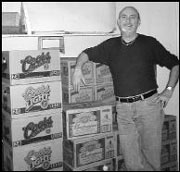RON SHMERELSON strode down the narrow back stairs to his authentic 1950s bomb shelter, heading straight to the walk-in beer cooler. He swung open a heavy door revealing a frosty array of aluminum kegs, chilled food supplies, and cases of cold ones. “There it is,” says Shmerelson, standing in the fortified basement of his Little Red Hen restaurant on Woodland Avenue in beautiful downtown Green Lake, “everything you need to survive.”
It seemed like a good time to be dusting off a bomb shelter if, like Shmerelson, you have one. Though the U.S. may have regained a better sense of security since Sept. 11, there’s still a fierce war going on in Afghanistan, the Middle East is a tinderbox, and the U.S. is mulling an invasion of Iraq.
Given all that has happened, Shmerelson says, opening doors into other storage areas within the Red Hen’s 600-square-foot bunker last week, “I’ve actually thought about cleaning the area up a little. I could use it for myself and a few others, if it became necessary.”
And why not? Our fearless leaders are already dug in. Their fortified hiding places include the nuke-ready White House Emergency Operations Center, where Dick Cheney was stowed after Sept. 11; the Pentagon’s bomb-proof control center, called the Tank; and the FBI’s impenetrable Operations Center, all bulwarked in steel and concrete. Members of Congress can also scurry to their fortified Capitol Hill basements.
Around the country, numerous other government buildings have bomb shelters, and even some of the lowest level bureaucrats are protected. At the Federal Emergency Management Agency (FEMA) command post in Bothell, for example, a two-level underground bunker is designed to hold 300 officials. Should they lose bodily control during an attack, the toilet—no kidding—has special rubber padding on the bottom to absorb shock waves.
Where’s that leave the rest of us, other than cowering in our shower stalls or making tracks for Canada?
Last week, underscoring all that, federal officials unveiled their latest fortification in the War on Terrorism, a D.C. control center for the Office of Homeland Security. Among its security features is its location: far enough from the White House to escape the blast from a medium-sized nuclear device, currently considered our greatest terror threat.
There is also growing fear over terrorist creation of nuclear “dirty bombs,” intended to spread radiation beyond the blast area.
That’s just the kind of threat that led to feverish building of nuclear fallout shelters like Shmerelson’s during the 1950s Cold War.
A former New Jersey nightclub operator, Shmerelson, 63, bought the venerable Little Red Hen two years ago. It has been a dark and cozy Green Lake institution for decades—by day a quiet hangout for neighborhood regulars, by night a crowded dance hall with live country-western music.
The basement blast shelter, built by a developer who took the Cold War seriously, has been mostly a secret except to some local old-timers. The site spreads out beneath a beauty salon and a martial arts studio in the same building. Shmerelson was delighted to discover the fortification after he took over. “The walls are two feet thick,” he says, patting them. “When they drilled holes to run lines from the kegs up to the bar, it took them almost two days.”
Red Hen cook Jeannie Smith says she likes the idea of a bomb shelter nearby, especially since “it’s the real deal.” High on one wall of the basement are the faded traces of a sign that declared the space an official fallout shelter. Similar leftover signs can be found in subbasements around the city. But if Seattleites suddenly needed shelter today, only a few thousand could squeeze into the reinforced bowels of downtown buildings or the bunker-style expanse under Freeway Park.
That leaves about a half-million people with no place to go, except maybe to make fast friends with Ron Shmerelson. He figures his shelter can hold 75 to 100 people. That brings up the questions that others faced 50 years ago: Who to let in? Who to keep out?
“I don’t know how I’d do that,” Shmerelson says, resting a foot on a stack of war supplies marked Budweiser. “I’ll at least need a bartender.”
Rick Anderson








